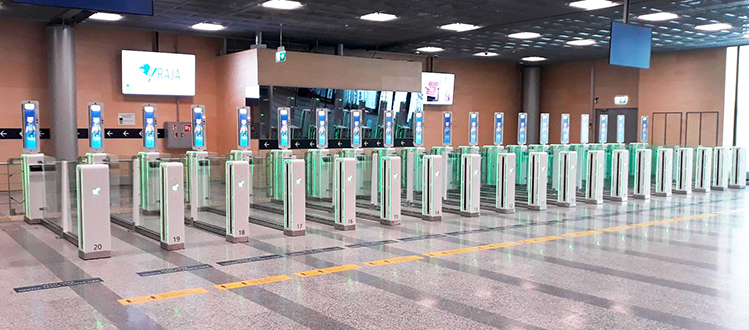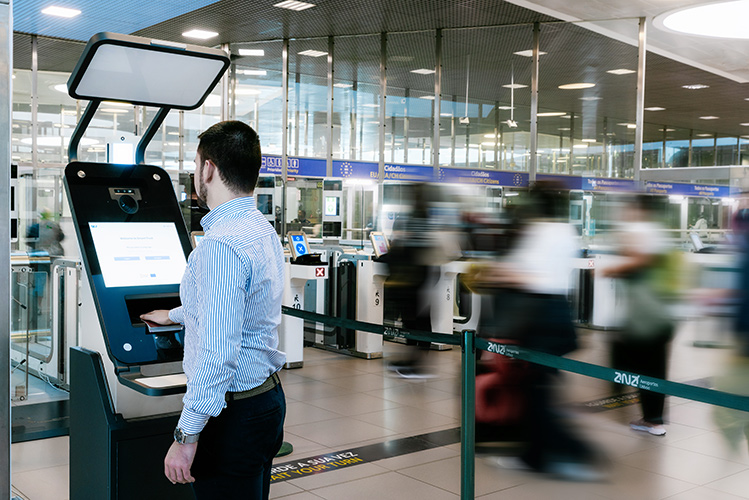As the February 2022 deadline for the implementation of the EU’s Entry/Exit System (EES) looms ever closer, how can Schengen border agencies best prepare for the months ahead? To find out, we sat down with digital identity evangelist, Jean-Francois (Jeff) Lennon, Head of Strategic Sales & Global Partnerships, Vision-Box, to explore the importance of learning through failure and embracing experimentation for a smooth roll-out of Smart Borders innovations.
While ‘failure’ is commonly associated with malpractice and poor preparation, Jeff explains the need to “reframe failure” into positive lessons and valuable insights to help border control agencies get closer to their objectives. The transformative scale and operational complexity of deploying standardised border controls across all 26 Schengen countries means errors and inefficiencies are inevitable.
EES is a human challenge
The first thing to understand about the EU Commission’s mandatory roll-out of Smart Borders and the EES is the complexity of deploying a harmonised initiative across thousands of human stakeholders. While the ultimate outcome of the initiative is to implement technology-focused solutions at Schengen air, land and sea borders, the reality is an overwhelmingly human challenge.
From negotiating billion-Euro budgets with government officials to training an IT border officer about how to respond to a network black-out, EES deployment revolves around coordinating stakeholders at all levels to work towards a shared vision of success.
Jeff explains how the best possible wedding between rules, practicality, and ease of implementation is all about bridging the gap between theory and reality. The daily challenges of a border guard and the on-the-ground nuances of specific border crossings are difficult to anticipate in a simulated environment – nothing compares to the reality of testing in the public domain.

Cross-border discrepancies with Smart Borders
It’s important to consider the social, economic and political challenges of deploying a standardised solution across multiple nations. Jeff highlights the diversity between Schengen nations and the challenging discrepancies that result in diverging attitudes towards Smart Borders.
Whether it’s a government not having enough resources to retrofit outdated hardware or the physical geography of a member state requiring tailored support, the human challenges of EES implementation vary on a case by case basis.
While EES infrastructure is pre-defined by eu-LISA, the practical requirements for each member state to reach compliance is often unclear. Discrepancy between nations and border agencies presents unique challenges in terms of justifying budgets, applying for funding, meeting deadlines, and potentially, dealing with penalties or funding withdrawals if a member state is unable to adhere to EU-mandated legislation.
Why is failure inevitable?
“The real test is not whether you avoid failure, because you won’t. It’s whether you let it harden or shame you into inaction, or whether you learn from it; whether you choose to persevere.”
- Barack Obama
As with any Europe-wide initiative, the roll-out of EES has not, and will not, come without its difficulties. Ever since the EU Commission’s suggestion of its Smart Borders package back in 2008, stakeholders at all levels have faced unusual set-backs, unforeseen obstacles, and uncontrollable errors.
It’s important to accept the inevitability of failure with an undertaking of this scale. While most walks of society view failure as a negative outcome or an inability to reach a given goal, developing resilience against failure and understanding how to move forward is critical to negotiate hurdles and get closer to success.
Building reliance against failure
So, how can border control agencies and key EES stakeholders stare in the face of failure and move forward with confidence?
The road to success requires an agile and flexible approach to negotiate the twists and turns of implementing tech-focused theories into on-the-ground applications.
Fostering an organisational culture that reframes failure into an exercise that provides critical data will help to inform future decisions. Jeff explains how the sheer volume of unknowns and uncontrollable variables at a border crossing demands highly-skilled and resilient teams that can maintain rigorous standards, regardless of the circumstances.
If border control agencies adopt a rigid and formulaic approach that relies on every piece of the puzzle falling perfectly into place, a single error could send the entire operation into disarray.
The importance of soft launches
Introducing new processes requires substantial training for on-the-ground personnel and a steep learning curve that will inevitably result in mistakes. While the EU provides member states with a dedicated task force in the shape of Frontex to support employee training and help border agencies prepare for February 2022, the real test begins when newly-trained personnel face real travellers.
In light of COVID-19 and its devastating impact on the global travel sector, Jeff explains how the sudden reduction in travellers provides a glimmer of positivity amidst an ongoing backdrop of uncertainty and instability. He describes the pressing need to “review and rewrite processes” and “learn from data insights before systems go live”.

“Implementing EES is not a big bang operation”
The reduction in travellers gives border control agencies a golden opportunity to run soft launches in a controlled environment. While personnel will still confront real-life challenges and must maintain rigorous security standards to process real travellers, soft launches provide a low-pressure environment to help border agencies get to grips with new processes.
Despite the ongoing impact of the pandemic, Advisory Partner at PwC, Serge Hanssens, explains how the travel sector must embrace this time to test hypotheses, experiment with new systems and build confidence across personnel. Instead of throwing border control agencies into the deep-end, COVID-19 presents a controllable environment to “ease their way in”.
Embracing EES experimentation
Experimentation sits at the core of reframing failure into a positive exercise. In the digital age, the implementation of Smart Borders empowers border control agencies with unprecedented access to data.
Whether it’s orchestrating the flow of passengers before they reach the physical border, generating predictive analytics to help border guards improve efficiency ahead of time, or tracking error rates to maintain rigorous security standards, EES provides a treasure trove of information to inform progress and guide risk-based decision-making.
Jeff explains how embedding experimentation into an organisation helps to “iron-out bumps” and take a series of small steps in the right direction. Successful EES experimentation involves setting a hypothesis about how a traveller may respond to a certain situation, testing it in practice, gathering results and drawing meaningful interpretations from this data.
While traditional pilot schemes often result in extensive reports that shape the general direction of a project, micro-experimentation is all about making continuous improvements through an agile ongoing cycle of testing. Instead of selecting an approach and hedging your bets on it being the best option, continuous experimentation provides an opportunity to optimise processes over time.
Supporting member states with experimentation & data insights
Jeff believes providing dedicated support to help member states unlock the power of data and embrace iterative experimentation is a critical success factor for EES implementation.
He describes the complexity and novelty of collecting data at this scale. While data has always played an important role in the movement of travellers across air, land and sea borders, the digital age provides a seemingly endless supply of rich and cleansed data that, if used correctly, can fundamentally re-shape the way border control agencies pro-actively operate.
Organisations like Frontex and eu-LISA are playing a pivotal role in educating and supporting individual border agencies with data collection, security, interpretability and interoperability. Jeff encourages member states to actively reach out to these organisations to gain access to extensive training, technical and operational support.

Why are fallback strategies necessary?
Ultimately, Jeff explains the importance of reliable fallback and mitigation strategies to facilitate a confident and sustainable approach to ‘reframing failure’. While we’ve established the value of learning from mistakes, it’s important to acknowledge the steadfast need for consistency and rigour when we’re dealing with the security and safety of the EU’s common external border.
While failures are acceptable in the context of EES implementation, complacency and negligence are not. Fallback strategies are vital to provide a safety net to protect border agencies against system errors and clear protocols for personnel to follow when they experience difficulties. For example, if a local system is full of bugs because a border agency didn’t have enough time to test and detect errors, they need a substantial fallback solution to process travellers manually, without compromising on national security.
Specifically, Jeff refers to harsh and challenging environments such as land borders with freezing temperatures or remote seaports with poor connectivity to fibre broadband or 4G. These unique situations require alternative solutions to create a harmonised and watertight system that supports maximum interoperability across member states and central EU platforms.
Learning from failure to champion success
Uniting stakeholders and supporting cross-border collaboration is an inherently challenging discipline that demands a highly-flexible and adaptive approach.
The “bumps in the road” of EES deployment require border control agencies to build resilience against failure and develop a clear idea of what success looks like. As Smart Borders technologies continue to provide exciting opportunities to streamline the illegal movement of people across the world and empower the ‘connected traveller’, guiding member states with hands-on support is critical to address case-by-case challenges.
Successful coordination and implementation of Smart Borders technologies require a holistic approach and a supra-collaborative effort to reach a common goal.
Want to learn more about the challenges and opportunities of cross-border connectivity?
Download the White Paper for an in-depth analysis of Smart Borders and the next frontier of travel.







